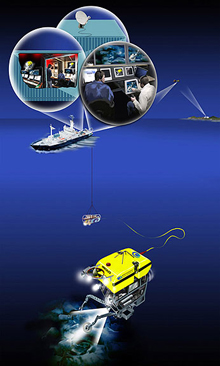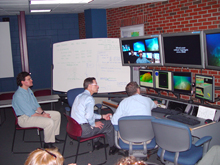
Telepresence technology uses satellite technology and Internet2 to transmit data and video in real-time from remotely operated vehicles (ROVs) working at depth, to a shore-based hub at the University of Rhode Island, which then sends this data to a variety of receiving stations on shore. Click image for larger view and image credit.
The Evolution of Telepresence Technology
Catalina Martinez
NOAA Office of Ocean Exploration
More than 25 years ago, Dr. Robert Ballard envisioned the use of satellite technology to allow scientists, teachers, and students on shore access to data and images from ships at sea in real-time. This concept of access in real-time is called "telepresence technology." Although still in development, telepresence technology has come to fruition in recent years, providing a virtual portal into the excitement of oceanographic discovery and helping demonstrate the importance of exploring our largely unknown ocean.
NOAA’s Office of Ocean Exploration (OE) has partnered with Dr. Ballard and the Institute for Exploration (IFE), and with personnel from the University of Rhode Island (URI), to develop this concept of a new paradigm for ocean exploration. Through several years of development and testing during joint expeditions, and through the installation of Exploration Command Centers on shore, NOAA OE is now preparing to initiate a major scientific and public outreach program from its new dedicated research vessel, the Okeanos Explorer that will include the use of telepresence technology. A new shore-based hub for this technology, called the "Inner Space Center," is in development at the University of Rhode Island’s Graduate School of Oceanography (URI GSO).

Retired Navy Vice Admiral Conrad Lautenbacher, PhD, (center), who serves as both the undersecretary of commerce for oceans and atmosphere and NOAA administrator, gets an introduction to the console at the University of New Hampshire (UNH) by Dr. Larry Mayer (right) and Dr. Brian Calder, both of UNH, Center for Ocean and Coastal Mapping. The photo was taken during a live interaction among four of the shore-based consoles — URI, UNH, the Pacific Marine Environmental Laboratory, and Silver Spring, Maryland — as they interacted with Dr. Robert Ballard and Webb Pinner of NOAA OE, at sea during a 2006 expedition to survey for ancient shipwrecks in the Sea of Crete. Click image for larger view and image credit.
Exploration Command Centers (ECCs) include consoles that are replicas of the ROV control-van system designed by IFE. The consoles include three plasma screens for viewing video transmitted from the ship, as well as an Internet-enabled intercom system, so that participants can converse simultaneously with several individuals at sea, and/or personnel at other remote consoles on shore. Currently, prototype ECCs are located at URI GSO; IFE in Mystic, Connecticut: the NOAA/University of New Hampshire (UNH) Center for Ocean and Coastal Mapping (CCOM) Joint Hydrographic Center; the Pacific Marine Environmental Laboratory (PMEL) in Seattle; and at a NOAA facility in Silver Spring, Maryland. There is also an educational test platform in the Smithfield High School in Rhode Island.
NOAA, URI, and IFE personnel are in the process of assessing the utility and future potential of these prototype consoles based on several years of testing during telepresence-enabled expeditions. Current designs will be altered based on the results of the assessments and as user needs are better defined. Operating procedures and management protocols are also in development.
The Aegean and Black Sea expedition will serve as a test platform for many of these efforts as we continue to collaborate with URI and IFE to refine process and protocol for the use of telepresence technology on the new NOAA ship Okeanos Explorer, and potentially on many other seagoing platforms. Stay tuned to see how the application of this technology evolves for oceanographic research and educational outreach!





